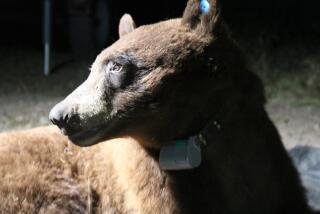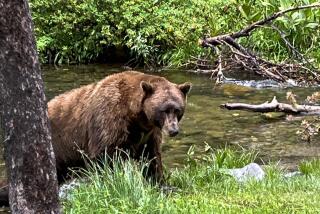More Country Bears Find a Taste for Suburban Life
Humans aren’t the only species undergoing rapid population growth in California; bears are proliferating too, especially near towns and urban centers tucked tightly against hills and mountain ranges.
When the weather warms, the big, hairy interlopers have been known to swipe pies from windowsills in Lake Tahoe, dumpster dive in Mammoth and Jacuzzi dip in Monrovia. Black bears have even shown up recently in such unexpected places as Riverside, Salinas, Santa Cruz and San Diego.
Last June, a 185-pound female bruin wandered down from the mountains into a Palm Springs subdivision, passing motorists and parents taking their children to school. The bear led authorities down several streets, then climbed a tree before authorities sedated the animal and released her in Chino Canyon.
These early-summer follies are indicators of a broader trend because bruins are on the march not only in California, but also in many other states. The animals are in the midst of a population explosion, their numbers having grown up to eightfold in California in 20 years, according to state wildlife officials.
Though it may seem incongruous that bears can multiply so prolifically across an urban landscape where human development has pushed aside most other mega-fauna -- including condors, elk and antelopes -- many biologists say development and a taste for high-fat human food are contributing to the bear boom.
In certain areas, such as Los Angeles County, Lake Tahoe and Mammoth Lakes, civilization creates conditions in which bears are more numerous near cities than in the wild.
Skilled opportunists, bears eat almost anything people consume, including pizza, fruit, hamburgers and sweets. As suburbia pushes farther into wild lands, the abundance of easy calories from rubbish, fruit trees and pet food has fundamentally changed the nature of California’s bears.
“Bears with access to human food get bigger; females hit puberty quicker and have more cubs,” said David Graber, a senior science advisor for the National Park Service.
For example, unlike wild bear food such as acorns and berries, garbage is high in protein and fat, which is why bears crave it. Fatter female bears produce more embryos, and many bears in Southern California are having litters of two or three cubs, compared to one or two naturally, said Kevin Brennan, a wildlife biologist for the state Department of Fish and Game.
A 2003 study of black bears in the Sierra Nevada found that those in urban areas and eating garbage weighed as much as 30% more than bears in wilderness areas. They also were significantly less active -- restricting their range from about 150 square miles to just a few blocks in urban neighborhoods. The study was published in the Journal of Zoology.
The state Fish and Game Department estimates that 33,260 black bears inhabit California today -- up from roughly 4,000 in 1984. Hunters have been taking about 1,800 animals annually in recent years, compared to about 1,000 per year 20 years ago, according to the department.
The bear resurgence also is occurring across much of the country. Pennsylvania has seen a sevenfold increase in bears in 20 years, and similar dramatic boosts have occurred in Virginia, Maine and New Jersey. Maryland and New Jersey had almost no bears a generation ago, but both states recently opened bear-hunting seasons.
“When you think of how much development has gone on in California -- it is not as wild as it once was,” Brennan said, “but we have bears as well as mountain lions showing up in neighborhoods.”
Monrovia Mayor Rob Hammond says he is proud that his city has learned to coexist with its wildlife. He lives on Norumbega Drive -- a secluded street squeezed between civilization and the San Gabriel Mountains that bears frequent.
“I’ve walked up on bears in my yard when I come home at night,” said Hammond, who last spotted two bruins on his property last summer.
“It’s like having a 400-pound Yogi staring you in the face. You ask yourself, ‘Am I really in Southern California?’ ”
Some scientists say that although development has helped sustain large, localized populations of bears, more human development will be harmful to the animals in the long run.
Habitat loss to building threatens to reduce their range. And as more towns encroach on wild areas, they put bears in direct contact with people; many animals end up losing in that clash.
Though some bruins flee when humans shoo them, others are aggressive, such as the one that was killed after it attacked a hiker and a Girl Scout troop in the Angeles National Forest three years ago while trying to steal food.
Black bears are not known to have ever killed a human in California, though encounters often are lethal to the animals because they are struck by cars or shot as pests.
“As subdivisions are built up and people move into wild lands, they take away wildlife habitat. The relationship between growth and numbers of animals is an inverse relationship -- more of one and less of the other” over the long run, said Doug Updike, senior wildlife biologist for the state Department of Fish and Game.
Other changes are contributing to the bear boom. Forests, logged after World War II, have grown back and support more of the blackberries, huckleberries, manzanita berries and wild strawberries that bears like.
“Bears are expanding into portions of California that were formerly grizzly habitat, in particular the Coast Range mountains from Mendocino into Santa Barbara and Southern California,” Updike said. “We’re seeing bears in places where we have not seen bears before.”
Though sightings are increasingly common in the foothill communities of the San Gabriel and San Bernardino mountains, no town in Los Angeles County has more ursine episodes than Monrovia. It occupies only 12 square miles, about 40% of it in the mountains.
“All the new buildings are against the foothills in areas where bears live,” said Tom Wright, a patrol sergeant for the Monrovia Police Department. During spring and summer, when bears are most active, he said, police respond to complaints about bears every day.
“They go through trash and eat avocados off trees,” Wright said.
Monrovia even has a bear awareness campaign that includes an ordinance prohibiting their feeding, and trash cans are booby-trapped with pepper spray. Six years ago, voters approved $9.5 million in taxes to buy hillsides for a 1,100-acre preserve to protect a wildlife corridor.
The city’s most celebrated black bear was Samson, a pool-dunking bruin whose antics competed for front-page news with the O.J. Simpson trial. Though Samson died in captivity at an Orange County zoo five years ago, Gary Potter, 55, remembers when the bear swam in his pool and roamed around his yard near the foothills.
As Potter, also a resident of Norumbega Drive, recalls: “He first came in the summertime when it got hot. At first, he came every now and then, and then it got to be more regular. He had a routine and would come down from the mountains and go swimming in the pool or the Jacuzzi. Then he’d go down the street and hit the trash cans, then he’d go eat avocados from the orchards until dawn. He was a big dude, and he’d just sit in the pool.”
Samson has been memorialized with a statue in Monrovia Canyon Park. But other bruins continue to follow in his path.
Potter found a sow and her two cubs in his yard this month. Unseasonably warm weather appears to have prompted bear activity earlier than expected this year.
“We see them almost every day,” he said. “Sometimes I come home and the sprinklers are moved, the pool sweeper is moved and there’ll be water and sticks, sand and berries in the pool, and I’ll say ‘Whoa, looks like there’s been a party here.’ ”






